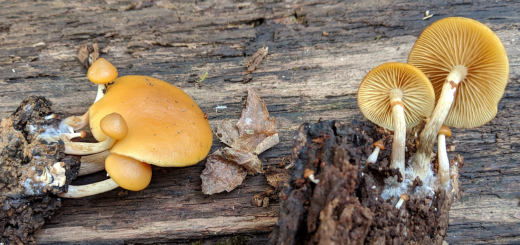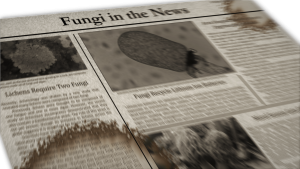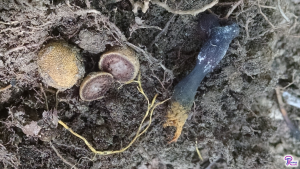#146: Gliophorus psittacinus, the Parrot Mushroom [Archived]
Note: This is an archived post. The current version of this post is available here.
This is a beautiful little waxy cap that displays one of the most striking color changes of all mushrooms. Gliophorus psittacinus is easily identified by its slimy texture and bright green color that becomes yellow as the mushroom matures. Because the color fades, older specimens are easily confused with the many other yellowish waxy caps. For easy identification of this mushroom, you really need to find young specimens that are still green and slimy. As with other waxy caps, the flesh has a texture reminiscent of candle wax. However, to experience this, one would first have to get past the considerable sliminess of the cap and stipe. Because of its initial bright green color (which one might term “parrot green”), G. psittacinus is commonly called the “Parrot Mushroom” or “Parrot Waxcap.” Indeed, the root word in its specific epithet means ‘parrot’ in both Latin and Greek.
G. psittacinus is a small mushroom with a hemispherical to flat cap and a central stipe. The mushroom grows to between 1 and 4cm (0.4-1.5in) tall and produces a pileus 0.5 to 3cm (0.2-1in) in diameter. North American West Coast specimens tend to be larger, growing 4-9cm (1.5-3.5in) tall and 1.5-4cm (0.5-1.5in) across. The pileus is the most readily seen and most striking part of the mushroom. It starts out small and hemispherical but expands to become convex or nearly flat. At first, the pileus is very slimy and dark green. Although the color is somewhat variable, most mushrooms start out some shade of green. This color quickly fades, however, and the cap takes on a yellow to orange hue. The fading starts at the center of the cap, so mature specimens often retain some of their green color around the edges. The pileus margin also frequently displays faint lines that trace the gills underneath.
Underneath the pileus, the mushroom forms gills, which are vertical plates of spore-producing tissue that radiate out from the central stipe. Generally, the gills are pale green at first and become yellowish or orange-yellow as they mature. Exactly when in development this change takes place varies between individuals, so the gills may already be yellow in some young specimens. The gills attach to the stipe at a roughly right angle, although they may run down the stipe some or recede from the stipe slightly. Parrot Mushrooms frequently produce short-gills, which start at the cap’s margin but do not run all the way to the stipe. Despite the gills’ coloration, the mushroom produces a white spore print.
The stipe supporting the mushroom is only a few millimeters thick and stays roughly the same thickness for its entire length. It is colored and textured like cap. The stipe starts out green and fades to yellow or orange from the bottom up. Older specimens occasionally retain some green at the top of the stipe, but most of the time the stipe fades completely to yellow. As with the cap, the stipe is smooth but quite slimy. Inside the stipe, the flesh is waxy and whitish with tones of yellow and green and surrounds a small hollow area at the center of the stipe.
The Parrot Mushroom can be found in North America and Europe on the ground in a variety of habitats from spring through fall or over winter in warmer climates. In Europe, the mushroom favors acidic or neutral grasslands that have not been fertilized. In North America, it prefers forests of either hardwoods or conifers. On both continents, it is often found growing in moss and/or along roadsides. The mushrooms may be numerous over a small area, but each mushroom is clearly separate from its companions. Waxy caps are traditionally considered saprobic, but they also seem to have some kind of mutualistic relationship with mosses. Moss is not necessary for the growth of G. psittacinus, since the last time I found this mushroom there was no moss around.
G. psittacinus is a rather variable species and may actually be a species group. In North America, at least, it seems likely that multiple species are hiding inside the mushroom’s current definition. Mycologists have yet to tease out any of these species, so for the moment they are all called G. psittacinus and the larger distinctions are separated out into varieties. European authors recognize two varieties: G. psittacinus var. psittacinus, which is the normal variety, and G. psittacinus var. perplexa, which does not have any green color at the top of its stipe. North America has a unique variety: G. psittacinus var. californicus. This version starts out blue and becomes red as it matures.
Older Parrot Mushrooms can easily be mistaken for many other smallish, yellow waxy caps. This can make them very hard to identify down to species. Frequently, traces of green can be found on the caps of mature mushrooms, which helps simplify identification. There are two other species of green-capped waxy caps in North America: Hygrocybe chlorochlora and Hygrocybe virescens. Both species are found in the Caribbean and Mexico and have a stipe that is dry to moist but never slimy. H. chlorochlora has a mostly yellow stipe while H. virescens has a mostly green stipe.
This fungus may be found listed under a few different names since it has been shuffled around between a number of genera over the years. Two common synonyms for G. psittacinus are Hygrocybe psittacina and Hygrophorous psittacinus. Hygrocybe and Hygrophorous are the two main genera of waxy caps, so either name would seem reasonable. The mushroom was moved to its current genus in 2013, which means many publications still list it under one of its older names. Among the waxy caps, the genus Gliophorus diverged after the Hygrophorous group and before the Hygrocybe group. G. psittacinus belongs to the phylum Basidiomycota, class Agaricomycetes, order Agaricales, and family Hygrophoraceae (the waxy caps).
G. psittacinus is listed as edible in most field guides, although it would take many mushrooms to make a decent-sized dish. Additionally, anyone tasting this mushroom would first have to get past its slimy texture. To the authors of RogersMushrooms, this texture is unpleasant enough and the taste bland enough that they recommend avoiding the Parrot Mushroom. In Europe, mycologists also recommend against eating G. psittacinus because the mushroom is rather rare and they therefore want to discourage collection for consumption.
See Further:
http://www.first-nature.com/fungi/hygrocybe-psittacina.php
http://www.mushroomexpert.com/gliophorus_psittacinus.html
http://www.mykoweb.com/CAF/species/Gliophorus_psittacinus.html
http://www.rogersmushrooms.com/gallery/DisplayBlock~bid~6155.asp
http://www.mushroomexpert.com/hygrophoraceae.html
http://link.springer.com/article/10.1007%2Fs13225-013-0259-0/fulltext.html








![#011: Characteristics of Kingdom Fungi [Archived]](https://www.fungusfactfriday.com/wp-content/themes/hueman/assets/front/img/thumb-small-empty.png)


